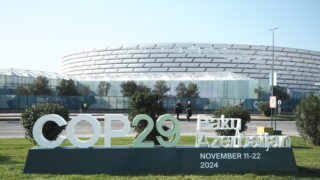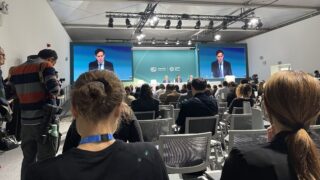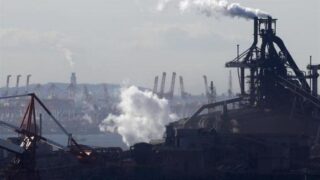こんにちは。京都事務所インターンのTKです。
先日、日本政府は新たな気候変動政策を発表しました。数年もの間、何もアップデートがなかったことを考えれば、発表それ自体は歓迎すべきことでしょう。期待していないことが起これば嬉しいものですが、今回の場合、母なる地球にとっては歓迎できないことかもしれません。大地が荒廃し、「京都議定書」(1997年採択)に始まった地球温暖化防止の取り組みの流れが悲惨な結末を迎える可能性もあるのです。
京都議定書の名前は、美しい古都「京都」にちなんで命名されました。かつて、日本は京都議定書がとりまとめられた会議の開催国として、地球温暖化防止の最前線でリーダー役を担っていました。しかし、今日の日本は、前進するかわりに後退し続けている状況です。
日本政府は、稼働停止中の原子力発電所の再開を計画している上、日本には、石炭火力発電所の43基もの新増設計画があります。これらの発電所が全て稼働した場合の温室効果ガス排出量は、現在の日本の総排出量の約10%を占めることになり、2050年時点に想定される温室効果ガス総排出の50%に相当します。
この2週間にわたり、政府の関係者は日本のメディアに対し、日本の温室効果ガス排出削減目標に関する様々な数値を非公式に伝えてきたようです。なぜ政府の役人は情報を流したのでしょう?政府関係者は国が気候変動政策に失敗していることを国民に知らせようとしているのでしょうか?
2030年までに2013年比で26%削減という日本の目標値がお話にならない数字である以上、政府は政策の失敗を認識していることでしょう。「はたしてこの目標値が正しいと思えるか?」と問われれば、答えは否定的にならざるを得ないでしょう。
では、この目標値を細かくみてみましょう。削減率から始めると、今回設定された目標値は高いように見えますが、2025年までに28%削減というアメリカの目標や2030年までに35%削減というEUの目標に比べれば、非常に弱い数字です。
次に、2013年比で26%削減するという目標では、日本が以前設定している2050年の排出目標(2050年までに80%削減)を達成する道筋にはつながりません。
最後に、日本は基準年を1990年から2013年へと変えています。この分野で一般的に1990年が基準年として採用されているのは、この年が「気候変動に関する国際連合枠組条約」や1997年の京都議定書での基準年だからです。にもかかわらず、日本はこの数字の目標を達成しやすくするために異なった基準年を使用したのです。2013年の日本の温室効果ガス排出量は、1990年以降の比較可能なデータの中では最悪の水準でした。このような見かけ倒しの戦略を使う日本政府の姑息なやり方は、恥ずべき行為です。しかし、安倍政権下ではこのようなやり方がとられることを想定しておくべきなのかもしれません。

Pressure is on Japan
Recently, the Japanese government announced their new climate change policy. After a period of several years, without an updated climate change policy, the news should be applauded. After all, when you don’t expect anything and it does happen, it puts a smile on your face. However, mother earth will not smile. Mother earth will be devastated, that the initiator of the Kyoto Protocol, fails miserably. The Kyoto Protocol, named after the beautiful ancient city of Kyoto. Japan used to be a leader on the front of preventing global warming, hosting the negotiations that led to the Kyoto Protocol. Yet today, instead of going forward, Japan is going backwards. Japanese government even plans to restart the idling nuclear power plants. In addition, Japan has 43 coal-fired power plants either planned or under construction. If built, those plants combined would have a carbon footprint equal to 10 percent of Japan’s current total emissions, and equal to 50 percent of the total emissions Japan aims to have in 2050.
Over the past couple of weeks, government officials have leaked various figures for Japan’s carbon reduction target to the Japanese media. First of all, why did the government officials leak information? Were they trying to inform the public of their own country failing on climate change policy ? Let’s hope so, because the Japan’s target for 2030 is a farce. Twenty-six percent below 2013 levels in 2030. Now, that seems quite right? Doesn’t it? No! Let’s break this down. First, the percentage. It seems high, but it isn’t. It is very weak compared to the U.S. target of 28 percent by 2025 and the EU target of 35 percent by 2030. Secondly, the 26 percent reduction would see Japan missing its preexisting 2050 emission target. Thirdly, all major economies are using 1990 as a base year. Why? Because this was implemented in the United Nations Framework Convention on Climate Change and the 1997 Kyoto Protocol. So, why is Japan using a different base year? To make its target more achievable. In 2013, Japan’s greenhouse gas emissions were one of the worst since comparable data became available in 1990. It is quite appalling from the Japanese government to use such a cheap trick. However, such methods would have been expected by Abe’s administration.
(抄訳:スタッフ杉本)
この記事を書いた人

- 気候ネットワークに所属されていた方々、インターンの方々が執筆者となっております。
最新の投稿
 活動報告2025年5月28日イギリス石炭火力発電終焉を取り巻く環境とは
活動報告2025年5月28日イギリス石炭火力発電終焉を取り巻く環境とは インターンの声2025年3月11日インターンが書くCOP29体験記②
インターンの声2025年3月11日インターンが書くCOP29体験記② インターンの声2025年1月31日インターンが書くCOP29体験記
インターンの声2025年1月31日インターンが書くCOP29体験記 活動報告2024年12月16日誰もが気になるアメリカの動向への対応
活動報告2024年12月16日誰もが気になるアメリカの動向への対応


